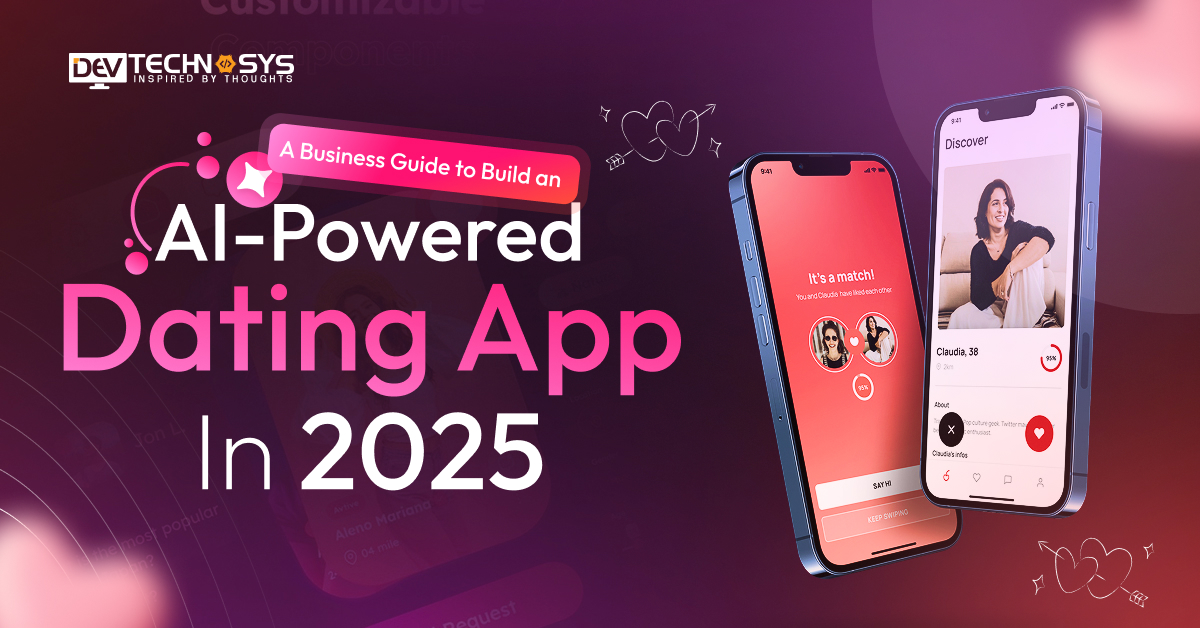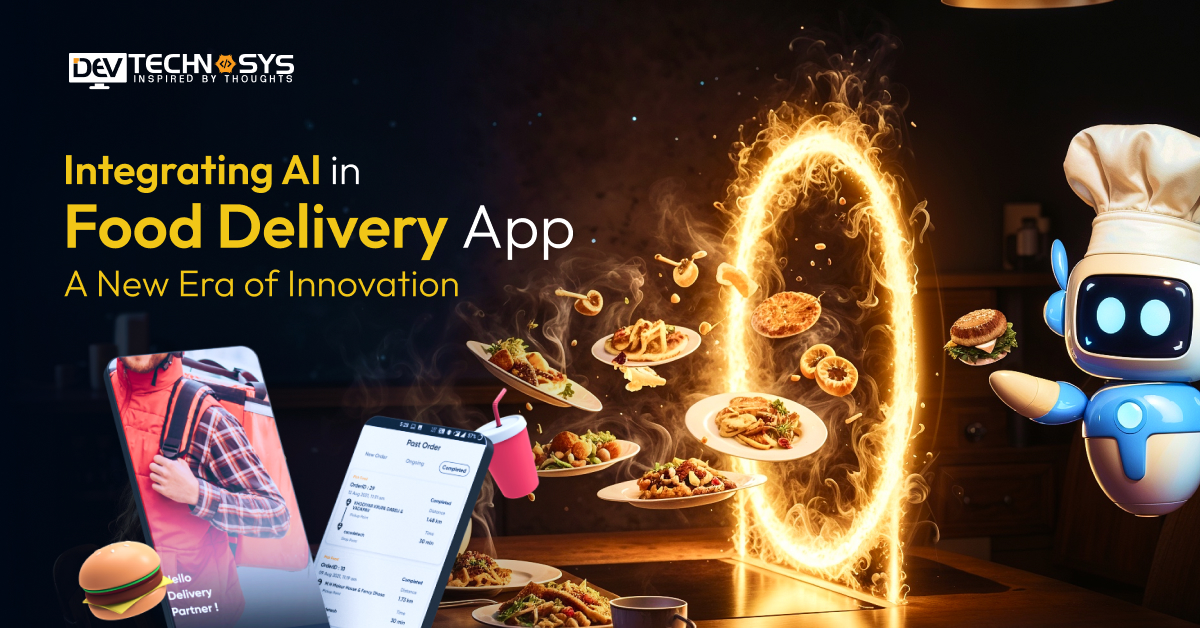Thanks to the evolution in the mobile app development industry, people can now satisfy their food cravings without leaving the comfort of their homes. Open the app, select the restaurant, place an order, pay, and boom! Your job as a customer is done; now, wait for your food to arrive in a few minutes; food ordering applications have made things that simple.
There are various top food delivery apps in UAE that deliver your favorite food, hot and fresh to consume, right at your doorstep with only a few taps on the mobile screen.
However, it takes a lot more than just hiring a top food app development firm to develop a food delivery app. There are a lot of steps involved in food delivery app innovation. If you are an entrepreneur or an emerging startup that wants to establish your presence in the food delivery app market by launching your own food ordering platform. In that case, this food app development guide is made for you!.
In our go-to guide for food app development, we will discuss various factors and aspects of food app development, including the technology stack & Features. We will also discuss why developing a food delivery app is a lucrative idea for businesses and also view some of the latest food delivery trends. So, buckle up friends!
What is a Food Delivery App?
A food delivery app is a mobile application or mobile platform that enables users to place food orders online from various restaurants and have them delivered to their address. These apps serve as a mediator for customers and restaurants, offering a convenience and a wide range of restaurant or cafeteria options.
Top food delivery apps in the UAE, such as Zomato and Deliveroo, allow users to browse menus, view photos, and read reviews of various popular restaurants and dishes. For order placement, users can select items they want to order, make adjustments to their orders, and add them to their virtual cart.
With multiple payment modes and real-time order tracking options, these apps are writing the future of innovation for today’s food delivery app businesses.
Food App Development Market Stats
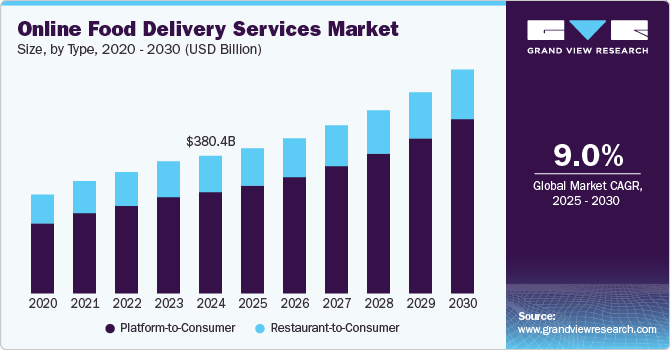
- Revenue in the Online Food Delivery market is projected to reach US$1.39tn in 2025.
- The global online food delivery services market is projected to reach USD 618.36 billion by 2030, growing at a CAGR of 9.0% from 2025 to 2030.
- The Grocery Delivery market is expected to show a revenue growth of 12.4% in 2026.
- The Grocery Delivery market has a projected market volume of US$938.98bn in 2025.
- Uber Eats is the most popular food delivery app, Delivery Hero has the most collective users.
- In the US, DoorDash is the most popular food delivery app, with over 50% market share.
How AI Is Influencing Food App Development in 2025?
In 2025, Artificial Intelligence (AI) is expected to become a dominant force in food delivery app development. AI enables custom suggestions by taking user’s preferences into consideration, ordering habits, and behavior patterns. Chatbots and voice assistants backed by natural language processing (NLP) enable customer support and caring orders to play seamlessly.
Predictive analytics optimize delivery routes, improve logistics, and reduce wait times. Restaurants utilize AI to manage inventory and forecast demand, thereby minimizing waste and enhancing efficiency. Dynamic pricing strategies and personalized offers enhance customer engagement and retention.
At the same time, AI also improves smart and safe transactions through real-time fraud detection. Additionally, health-focused features such as nutritional tracking and dietary suggestions are driven by AI, making food apps more intelligent, intuitive, and responsive to user needs.
Why Should Businesses Invest in Food App Development in UAE?
The food delivery app business is skyrocketing. Here are some of the major reasons to invest in restaurant mobile app development:
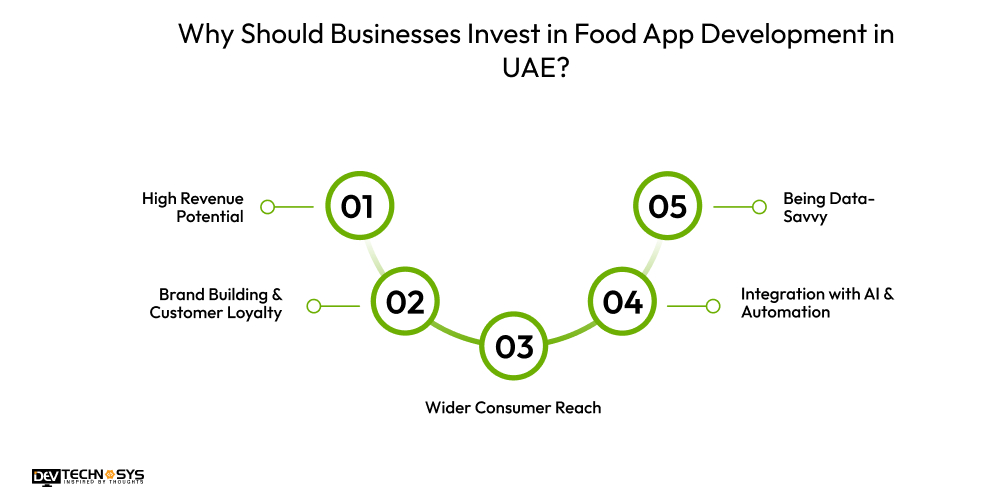
-
High Revenue Potential:
A food ordering platform creates a direct sales channel, boosting order frequency and value by offering personalized upsells and directly reaching more customers.
-
Brand Building & Customer Loyalty:
It improves brand visibility in the competitive market, fosters direct customer engagement via personalized touch, and develops loyalty through in-app programs and user feedback.
-
Wider Consumer Reach:
iOS app development meets modern consumer expectations for mobile convenience, allowing businesses to tap into new demographics and use location-based marketing.
-
Integration with AI & Automation:
Make a food delivery app with AI that streamlines operations, tailors customer experiences with smart suggestions, and simplifies logistics for better efficiency.
-
Being Data-Savvy:
A top food delivery app like Talabat is quite popular in the UAE food delivery market. Collect invaluable customer and operational data, enabling businesses to make informed, strategic decisions on menus, marketing, and growth.
Top 10 Food Delivery Apps in UAE to Consider in 2025
Here are the top 10 food delivery apps in UAE to consider in 2025:
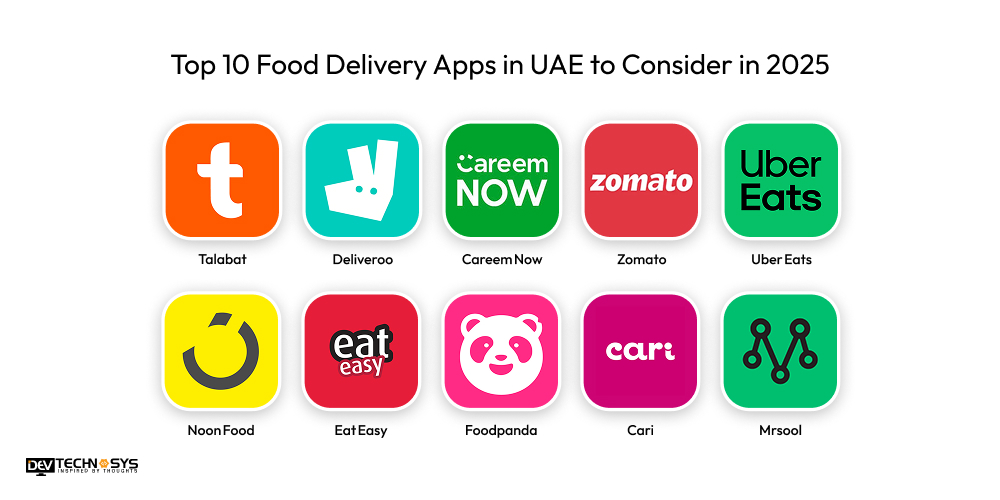
App Name |
Launch Year |
Avg Rating (Play / App Store) |
Platforms |
| Talabat | 2004 | ≈ 4.4★ / 4.6★ | iOS & Android |
| Deliveroo | 2015 (UAE) | ≈ 4.3★ / 4.5★ | iOS & Android |
| Careem Now | 2018 | ≈ 4.3★ / 4.5★ | iOS & Android |
| Zomato | — (UAE exited 2022) | ≈ 4.6★ / 4.6★ | iOS & Android |
| Uber Eats | 2017 (UAE) | ≈ 4.2★ / 4.4★ | iOS & Android |
| Noon Food | ~2021 | ≈ 4.0★ / 4.2★ | iOS & Android |
| Eat Easy | 2021 | ≈ 4.1★ / 4.3★ | iOS & Android |
| Foodpanda | 2012 | ≈ 4.2★ / 4.4★ (UAE) | iOS & Android |
| Cari | — (recent) | ≈ 4.0★ / 4.2★ (Gulf) | iOS & Android |
| Mrsool | 2015 | ≈ 4.0★ / 4.3★ (UAE) | iOS & Android |
Food Delivery Business Model
Are you a restaurant owner wanting to develop a food delivery application with the latest features? You should know about the major business models you should consider. So, with further delay, let’s conduct a detailed discussion and explore the advantages.
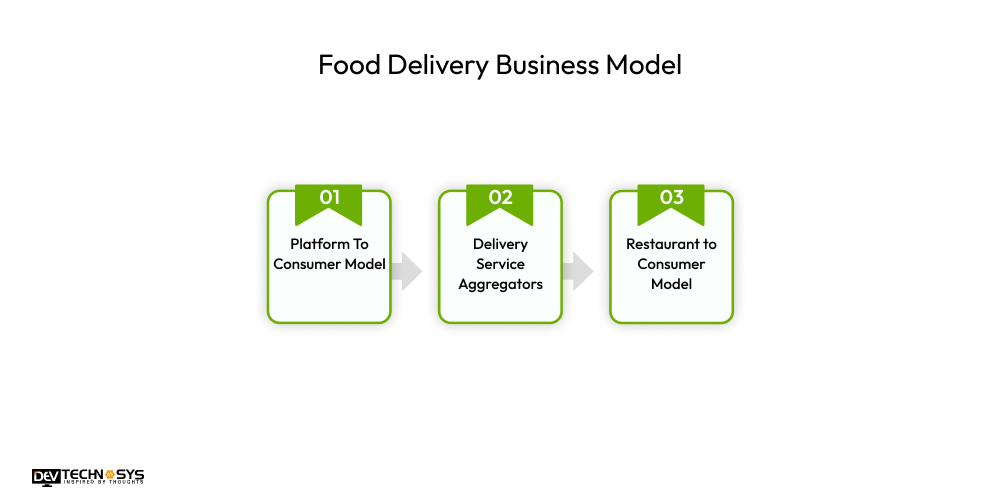
1) Platform To Consumer Model
Uber Eats and DoorDash are two of the most famous food delivery apps examples that utilize the platform for the consumer model. This is a business model that gathers everything that small restaurants have to offer and lets customers place orders through an online app platform.
In this model, the business partners and restaurants are themselves responsible for their own fleet of couriers. It is highly profitable as platforms make revenue from restaurants as well as customers by making them pay a small fixed amount as a fee for each other.
2) Delivery Service Aggregators
The delivery service aggregator model is basically a part of the platform-to-consumer model. But it’s completely worth being separated.
The platform acts as a bridge for customers (users) and countless local restaurants, operating under an aggregator model. If customers face any issues with their deliveries or with placing , they provide customer support on behalf of the restaurants in UAE.
Here, with every successful transaction the platform charges a fixed amount of fee. Grubhub, Eat, and Delivery Hero are food delivery platforms that utilize this particular model.
3) Restaurant to Consumer Model
In the Restaurant Consumer Model, restaurants serve food to their customers from their locations. McDonald’s, Burger King, and Domino’s are some of the popular following this model.
Moreover, these companies integrated food delivery into their websites and apps or partnered with delivery platforms to modernize their approach. In addition, they can partner with food delivery services like DoorDash, so they don’t require to serve all by themselves.
Domino’s is a true game changer for the food-delivery industry. Some of the newest food delivery app innovation offered by the company entails:
- Using a voice recognition system for order placement.
- An app that lets users track delivery while it is on its way.
- Drones are being tried and tested for automated delivery.
Key Features of Food Delivery App Development
Now, we have reached one of the most important sections of this food app development guide, the features. If you wish to build a food delivery app that stands out in the constantly evolving and competitive food delivery app industry, then consider adding the essential features given below.
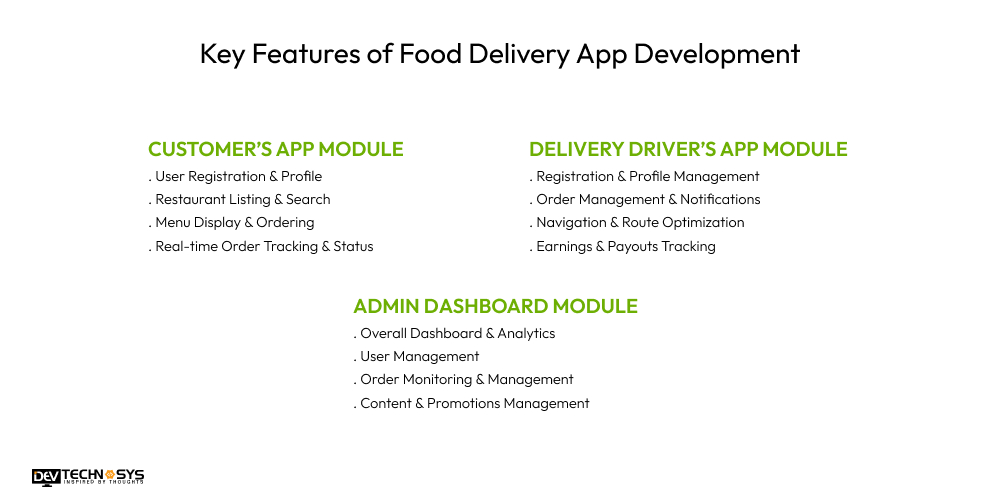
Customer’s App Module
1. User Registration & Profile: For food restaurant app development, you need to incorporate simple user registration features. Easy sign-up, profile management, saved addresses, and payment methods.
2. Restaurant Listing & Search: Geolocation-based restaurant discovery with robust search, filters (cuisine, price), and detailed restaurant profiles. This is a crucial feature, especially if you wish to develop a food delivery app in the UAE.
2. Menu Display & Ordering: Developers incorporate Interactive menus with customization options to make a food delivery app like Deliveroo or Talabat, real-time cart management, and scheduled order placement.
4. Real-time Order Tracking & Status: To create a food delivery App, it is crucial to include live GPS tracking of deliveries, push notifications for order updates (preparation, pickup, en route), and estimated delivery times.
Delivery Driver’s App Module
1. Registration & Profile Management: Driver onboarding, profile setup, vehicle details, and online/offline availability toggle.
2. Order Management & Notifications: Instant alerts for new delivery requests, options to accept/reject orders, and access to all order details.
3. Navigation & Route Optimization: Integrated in-app GPS navigation with optimized routes for efficient, multi-stop deliveries.
4. Earnings & Payouts Tracking: Transparent display of earnings history, completed deliveries, and management of payout details.
Admin Dashboard Module
1. Overall Dashboard & Analytics: A comprehensive overview of all operations, including sales, active orders, and key performance indicators.
2. User Management: To create a food delivery app, you need some fantastic tools to manage and oversee all customer, restaurant, and delivery partner accounts, including onboarding and approvals.
3. Order Monitoring & Management: Ability to track, intervene, and manage all active and past orders, including manual assignment if needed.
4. Content & Promotions Management: To create a food delivery app, form control over app content, banners, restaurant listings, and the creation/management of all in-app promotions and discounts.
Steps To Create A Food Delivery App
The Android App Development Services entails the following crucial steps. Here’s the list of steps for app development that are followed for the food ordering application development project. Your team also needs to follow Flutter app development best practices to ensure your app is as efficient as possible.
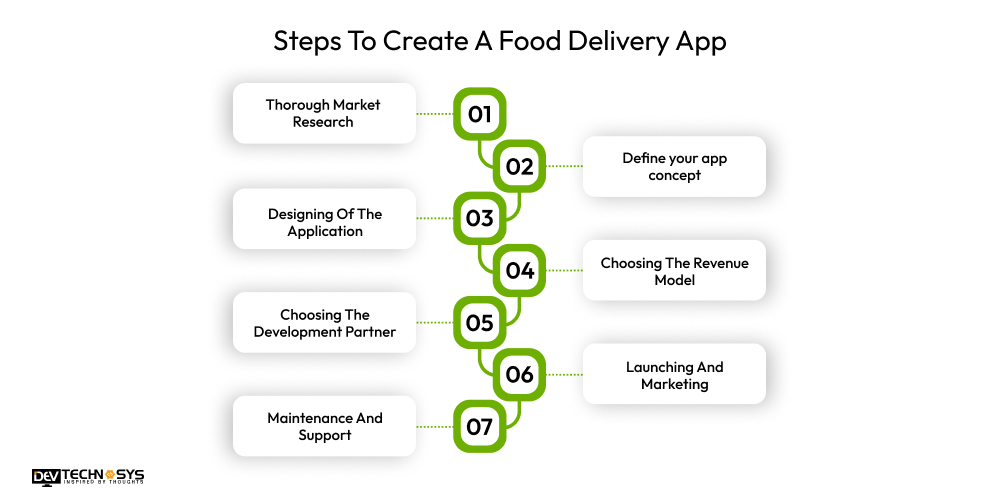
1. Thorough Market Research
The first step to follow before creating an application for food delivery is to research the use and target audience of the app. Market research will give you an idea of the market your company is entering and the competitors present. Through research, your team will be able to find the problem statement for the application.
Important Questions |
| Why is market research important before app development? |
| What tools can be used for effective market research? |
| How long should market research take? |
2. Define your app concept
Defining your app concept is the foundation of a successful food delivery app. It involves identifying your business model, target audience, and core features to ensure your app aligns with user expectations and market trends. A clear concept allows you to build a solution that’s not only functional but also competitive and scalable in 2025’s dynamic digital landscape.
Here are the key elements of the app concept definition:
- Business Model: Choose between aggregator, logistics-based, or full-stack models based on control and scalability.
- Target Audience: Identify specific user groups, urban millennials, families, office workers, or niche markets like vegan or fitness-focused customers.
- Unique Selling Proposition (USP): Include features that set you apart like zero delivery fees, ultra-fast service, or curated restaurant partners.
- Platform Focus: Decide if your app will be Android, iOS, web-based, or cross-platform for maximum reach.
- Core Features: include useful features like real-time tracking, multi-payment support, customer reviews, push notifications, and loyalty rewards.
Important Questions |
| What should be included in the app concept? |
| Who should define the app concept? |
| Can I update my app concept after launch? |
3. Designing Of The Application
The food delivery app development company must present the idea to programmers and designers for design input. Application and UI designers help develop the wireframe of the food delivery application before it undergoes the process of development. According to the design features and wireframes, the app is developed on the back end. There are several phases in the food delivery app development process, and the app is thoroughly tested.
Important Questions |
| What does UI/UX design involve in a food delivery app? |
| Should design be mobile-first? |
| How long does the design phase take? |
4. Choosing The Revenue Model
The revenue model of the UAE-based food delivery app is decided by the management. The food delivery process platforms generate revenue for the business, and the payment methods splitting the revenue between restaurants and the app must be decided from the outset. A transparent and reliable model is needed in its prices and positioning. Having a cross-platform application can also help you lower development costs while doubling your user base.
Important Questions |
| What are the common revenue models for food delivery apps? |
| Can I use more than one monetization method? |
| Should the revenue model be tested before full launch? |
5. Choosing The Development Partner
You need to select one of the leading food delivery app development companies so that your team can produce the best product using the most effective methodology. To choose the best possible food app development providers for your project, you should consult with your peers and internally.
Try to find development providers depending on their case studies and the work they do. Hire food app developers who know the best cross-platform mobile app development frameworks.
Important Questions |
| What should I look for in a development partner? |
| Is it better to hire freelancers or an agency? |
| What questions should I ask a potential developer? |
6. Launching And Marketing
Once the food ordering app is ready, you need to market the application properly. A top food delivery app development company should recommend and help you choose the most successful promotion and marketing strategies for your food delivery app.
With the help of social media and advertisements, you can promote your app successfully and achieve the goal of generating revenue from the top food delivery app.
Important Questions |
| When is the right time to launch my app? |
| What are effective marketing strategies for food apps? |
| Should I do a soft launch first? |
7. Maintenance And Support
Maintenance and support may be the last but most crucial phase of food app development services. The development and testing team has to provide maintenance and support services after the app is successfully deployed. This step is crucial to ensure the app’s long-term success.
Technical issues or bugs are not uncommon in such platforms, so hire a top app development company with an expert maintenance and customer support service provider team who would address such issues and quickly figure out the best possible solutions.
Important Questions |
| What does post-launch maintenance include? |
| How often should I update my app? |
| Is support important even after the app is stable? |
Cost to Develop a Food Delivery Application
The cost of creating a food delivery app differs depending on various factors. It may include the essential and advanced features, tech stack, platform choice, and development team location. Generally, the cost of food delivery app development can range from $10,000 to $ 30,000 or more, based on complexity and scale.
A basic MVP (Minimum Viable Product) with core features like restaurant listing, ordering, and payment may cost around $15,000–$25,000.
However, more advanced apps with AI-powered recommendations, real-time delivery tracking, multiple user interfaces (for customers, delivery partners, and restaurants), and admin panels can push the cost to develop a mobile app to $30,000 or even higher.
App Type |
Estimated Cost (USD) |
Development Time |
| Basic App (MVP) | $8,000 – $13,000 | 2 – 3 months |
| Mid-Level App | $15,000 – $20,000 | 4 – 6 months |
| Advanced App (Full Features) | $22,000 – $30,000+ | 6 – 9+ months |
Factors Affecting the Cost to Create a Food App Development
Here are some of the major factors that can influence the food delivery app development cost:
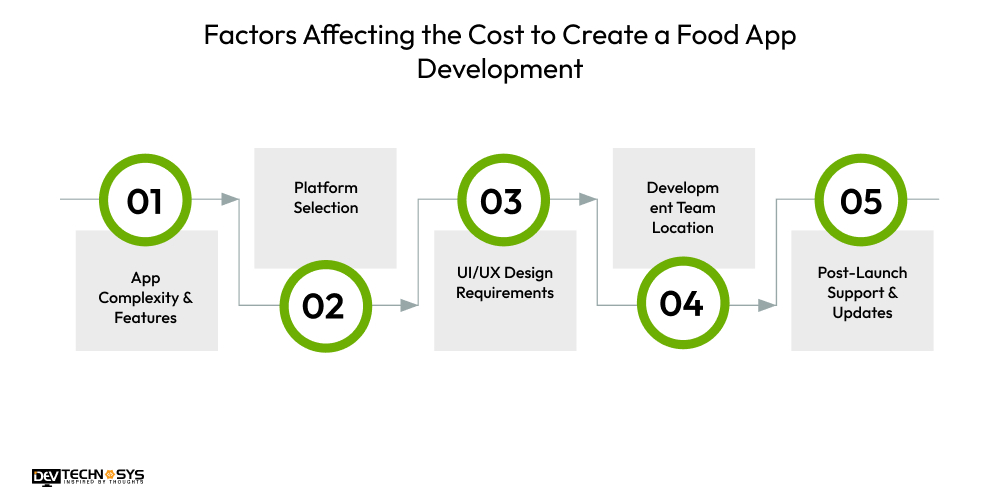
1. App Complexity & Features
The cost of creating a food app rises with the number of features and functionalities you add. A basic version with simple features like menu browsing and order placement does not cost that much. However, adding advanced features like real-time GPS tracking, AI-powered food suggestions, chat support, and loyalty rewards can surely raise development time and cost.
Complexity Level |
Estimated Cost (USD) |
Development Time |
| Basic (MVP) | $8,000 – $12,000 | 1.5 – 2.5 months |
| Moderate (Order tracking) | $13,000 – $20,000 | 2.5 – 4 months |
| Advanced (AI, loyalty, chat support) | $21,000 – $30,000 | 4 – 6 months |
2. Platform Selection
Building for one platform (Android or iOS) is more cost-efficient than building for both. Alternatively, using cross-platform frameworks like Flutter or React Native allows simultaneous development for Android and iOS, reducing both time and expenses. Native app development comparatively costs more to separate coding efforts.
Platform Type |
Estimated Cost (USD) |
Development Time |
| Android or iOS (single) | $8,000 – $15,000 | 1.5 – 2.5 months |
| Cross-platform (Flutter/React Native) | $13,000 – $20,000 | 2 – 3 months |
| Native (Both platforms separately) | $20,000 – $30,000 | 3.5 – 5 months |
3. UI/UX Design Requirements
A tailored, user-centric design helps your app gain more market presence and cost due to the time and effort needed to create it. Basic designs with standard elements are cheaper, but they may not offer the best user experience, which is critical for customer retention in competitive markets.
Design Type |
Estimated Cost (USD) |
Development Time |
| Basic Design | $2,000 – $4,000 | 2 – 3 weeks |
| Custom UI/UX | $5,000 – $8,000 | 3 – 5 weeks |
| Advanced Interactive Design | $8,000 – $10,000 | 1 – 1.5 months |
4. Development Team Location
Hourly rates vary widely depending on geography. If you hire dedicated developers from the U.S. or Western Europe, then the charges would be around $80–$150/hour, while those in Asia or Eastern Europe typically charge between $20–$50/hour. Outsourcing to experienced offshore development teams can significantly reduce costs without compromising quality.
Region |
Hourly Rate (USD) |
Approx. App Cost* |
Development Time |
| US / Western Europe | $80 – $150/hr | $25,000 – $30,000 | 3 – 4 months |
| Eastern Europe | $40 – $70/hr | $15,000 – $22,000 | 2.5 – 3.5 months |
| Asia (India, Philippines) | $20 – $50/hr | $8,000 – $18,000 | 2 – 3 months |
5. Post-Launch Support & Updates
App development needs constant upgrades and maintenance services. After launching your food delivery app, ongoing support becomes a necessity to ensure smooth implementation, user satisfaction, and a tool for the long-term success of the app. The cost to maintain an app typically includes bug fixing, feature upgrades, performance optimization, server maintenance, and user support.
Support Plan |
Annual Cost (USD) |
Coverage |
| Basic (bug fixes only) | $1,000 – $2,000/year | Monthly maintenance |
| Moderate (updates + support) | $2,500 – $4,000/year | Bug fixes, minor updates |
| Comprehensive (ongoing development + support) | $5,000 – $7,000/year | Feature enhancements, server scaling, security patches |
Monetization Strategies For Food Delivery Apps
Here are the monetization strategies businesses can use to generate revenue from their food delivery apps:
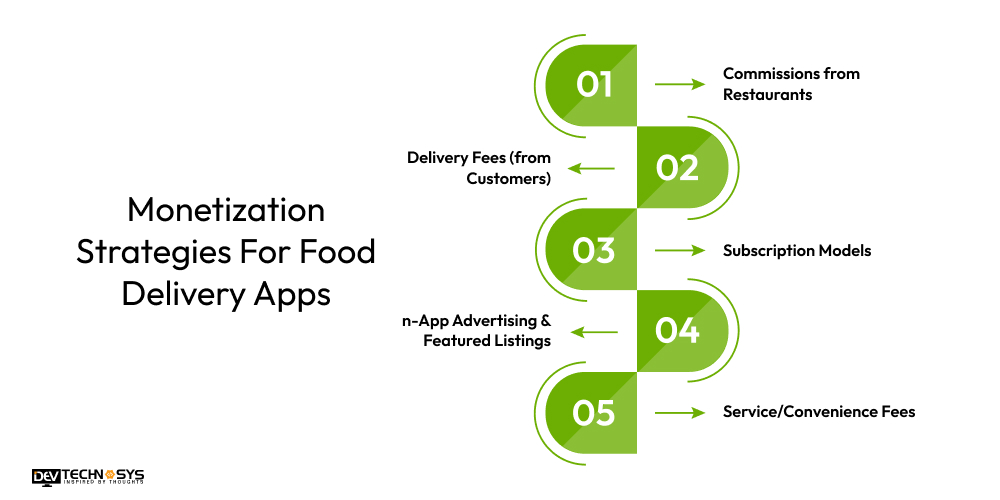
- Commissions from Restaurants: The most common method, where the app takes a percentage of every order placed through its platform from the restaurant.
- Delivery Fees (from Customers): Charging customers a fee for each delivery, which can vary by distance, order value, or during busy times.
- Subscription Models: Offering customers recurring memberships for benefits such as free deliveries or reduced fees.
- In-App Advertising & Featured Listings: Restaurants pay to get more visibility by having their listings promoted prominently within the app.
- Service/Convenience Fees: A small charge is added to each order to cover platform operational costs and customer support.
- Cloud Kitchens/Private Labels: The app operates its own delivery-only restaurants or exclusive food brands to capture higher margins.
Top Food Delivery Trends in 2025
Here we present top 5 food delivery trends to look out for in 2025:
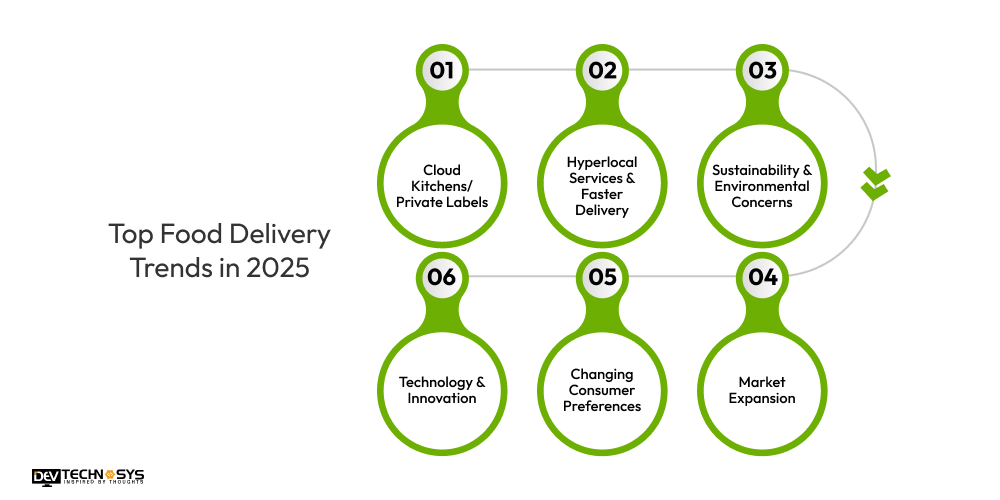
- Hyperlocal Services & Faster Delivery: The focus is on ultra-fast delivery, often under 30 minutes, by leveraging highly optimized routes and strategically located cloud kitchens.
- Sustainability & Environmental Concerns: A strong push for eco-friendly packaging and optimized routes using electric vehicles to minimize carbon footprint in deliveries.
- Technology & Innovation: AI is driving hyper-personalization, advanced logistics, voice ordering, and the increasing use of robots and drones for delivery.
- Changing Consumer Preferences: Consumers demand more personalized, healthy, and ethical options, with a growing interest in subscription models and social media-driven food trends.
- Market Expansion: The industry is expanding into smaller cities and due to that they are evolving into “super apps” that offer a wide and diverse range of services that go beyond food, alongside the rising popularity and demand of cloud kitchens.
Conclusion
In the above blog, we discuss food app development in detail. We hope this guide gives you the foundation to build a competitive, future-ready food delivery app. Food app development in 2025 demands more than just an appealing interface. It requires a smart blend of user-centric features, advanced technology, and scalable infrastructure.
Whether you’re building a restaurant app, cloud kitchen app, or a custom food ordering platform, selecting the right technology stack, defining essential features like real-time tracking, secure payment gateways, and smart recommendations, and aligning with the latest AI and automation trends are key to success.
If you are a business wanting to create a high-performing app that meets user expectations and drives long-term business growth, then consult our experts at Dev Technosys, a leading mobile app development company in UAE, and stay tuned for more informative updates.
FAQs
1. What Are The Essential Features Of A Food Delivery App?
The key features of the food delivery app include user registration, menu browsing, order placement, real-time GPS tracking, secure payments, ratings & reviews, and customer support.
2. How Much Does It Cost To Develop A Food Delivery App?
The cost of a food delivery app depends on features, platform, and complexity. Generally, it ranges from $8,000 to $30,000.
3. How Long Does It Take To Develop A Food Delivery App?
Food delivery app development time can vary between 2 to 6 months, depending on app complexity, platform choice, and design requirements.
4. Which Technology Stack Is Ideal For Food Delivery App Development?
Popular stacks include Flutter or React Native for frontend, Node.js or Django for backend, and Firebase or AWS for database and cloud services.
5. How Can Food Delivery Apps Generate Revenue?
Apps can earn through delivery charges, restaurant commissions, ads, subscriptions, premium listings, and affiliate partnerships.







